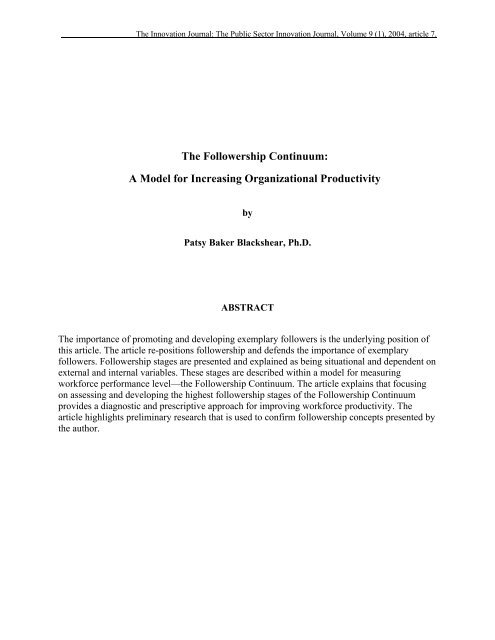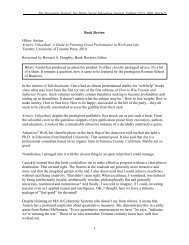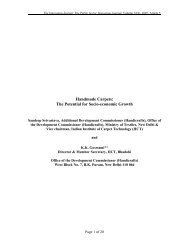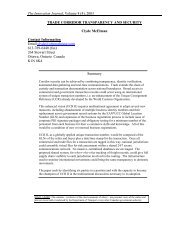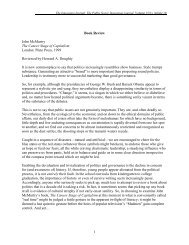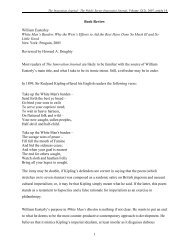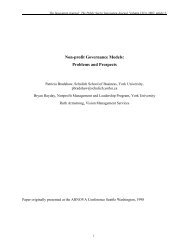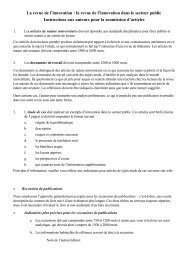The Followership Continuum - The Innovation Journal
The Followership Continuum - The Innovation Journal
The Followership Continuum - The Innovation Journal
Create successful ePaper yourself
Turn your PDF publications into a flip-book with our unique Google optimized e-Paper software.
<strong>The</strong> <strong>Innovation</strong> <strong>Journal</strong>: <strong>The</strong> Public Sector <strong>Innovation</strong> <strong>Journal</strong>, Volume 9 (1), 2004, article 7.<br />
<strong>The</strong> <strong>Followership</strong> <strong>Continuum</strong>:<br />
A Model for Increasing Organizational Productivity<br />
by<br />
Patsy Baker Blackshear, Ph.D.<br />
ABSTRACT<br />
<strong>The</strong> importance of promoting and developing exemplary followers is the underlying position of<br />
this article. <strong>The</strong> article re-positions followership and defends the importance of exemplary<br />
followers. <strong>Followership</strong> stages are presented and explained as being situational and dependent on<br />
external and internal variables. <strong>The</strong>se stages are described within a model for measuring<br />
workforce performance level—the <strong>Followership</strong> <strong>Continuum</strong>. <strong>The</strong> article explains that focusing<br />
on assessing and developing the highest followership stages of the <strong>Followership</strong> <strong>Continuum</strong><br />
provides a diagnostic and prescriptive approach for improving workforce productivity. <strong>The</strong><br />
article highlights preliminary research that is used to confirm followership concepts presented by<br />
the author.
<strong>The</strong> <strong>Followership</strong> <strong>Continuum</strong>:<br />
A Model for Increasing Organizational Productivity<br />
Like the mythical Jason and the Argonauts, organizations and their leaders constantly seek their<br />
own magic bullet for improving productivity. <strong>The</strong>se bullets present themselves as that special<br />
program, that renowned management guru, that visionary CEO, that better marketing plan to best<br />
position the company, or other current fads. <strong>The</strong> search is driven by a constant requirement to<br />
perform better, do more for less, exceed customer expectations, or compete successfully in the<br />
marketplace. <strong>The</strong> bottom line must continuously improve. While problems and issues in<br />
organizations vary and change is the only constant, the requirements to perform remain the same.<br />
If the industry is in the private sector, there is the small business struggling for survival or the<br />
large business trying to maintain market share. In the non–profit sector, there is the requirement<br />
of sustaining and increasing funding support to ensure program integrity and quality. In the<br />
public sector, be it local, state or federal, there is the need to serve constituents, the need to<br />
ensure that programs operate successfully, and the need to provide services that optimize limited<br />
resources, while creating strategic direction for future advancements.<br />
However, the strategies that consistently make the difference are those that mobilize and engage<br />
individuals to perform at their best. New tools and techniques or better leadership will not do the<br />
job unless there are followers who get on board. Programs, policies and procedures can create<br />
the environment for productivity. But the primary agent of productivity is the organizational<br />
workforce. <strong>The</strong> key requirements for ensuring and sustaining organizational productivity are<br />
mobilizing and developing the workforce, the organizational followers.<br />
When the organization is viewed as a unified system, it becomes clear that all organizational<br />
elements are crucial for sustained productivity. However, without the “right” human capital<br />
factors, the right followership, the organization barely moves, or it lurches along. Reflect on this<br />
by looking at the organization and its components (i.e. the leader, the systems, and the followers)<br />
in the context of a car and all its component parts. Could you drive a car (the organization) with<br />
just a steering wheel and the drive train (the leader)? Like cars, organizations need all<br />
components working together for full functionality. Tires, seats, windshield wipers, and other<br />
supporting components (systems) are important features of a fully working car. But, the car<br />
doesn’t run without the engine, the battery, and gasoline (the followers). <strong>The</strong>se components give<br />
the car its power.<br />
Demystifying the Myth About Followers<br />
<strong>The</strong> Case for the Importance of Followers -But who wants to be a follower? This should be an<br />
obvious question in discussions about increasing productivity in the workforce. Because the<br />
general view held about followers is that of a submissive and subordinate role, people who are<br />
somehow sub-par.<br />
2
We have all had experiences in which we were urged to be a leader: “Don’t just follow along,<br />
think for yourself.” Reproaches such as this one are replayed over and over and are part of our<br />
repeating mental film. <strong>The</strong> reality is that our perceptions about followers and followership are<br />
grounded in positioning. And for many, our mental reruns have positioned followers as being<br />
second best.<br />
Consider the mental positioning of the General Electric Company products. Many of us perceive<br />
electrical appliances as this company’s primary products, possibly encompassing related or<br />
vertical electrical product lines. But, in reality the General Electric Company is a conglomerate,<br />
with horizontal product lines that span many industries, including ownership of NBC, a<br />
television network, and insurance and financial institutions. Likewise, followership is positioned<br />
as a passive role that is dependent on the directions and actions of another--a superior, the leader.<br />
Like General Electric, the reality for followers is different, as well.<br />
In actuality, followership is a relationship between followers and leaders, one of co-dependent<br />
roles rather then dependent ones.<br />
Philosophically, from childhood, our focus has been on being a leader and has been directed<br />
away from the importance of followers. Maybe this one-sided focus has resulted in the<br />
undervaluing of followership. Yet no organized effort can succeed or be sustained without<br />
followers. Without military followers, brigades or platoons couldn’t accomplish their missions.<br />
How would religions grow and be sustained, if parishioners and disciples didn’t follow? And<br />
just imagine the Super Bowl without a team of followers. Who would receive and carry the ball;<br />
who would block; and who would kick or punt, if everyone coached? Each of these team<br />
members provide critical, but different, expertise. Success in these organized efforts occurs from<br />
the combined efforts of many people working together. <strong>The</strong> contribution of followers to<br />
organizational productivity is irrefutable; the case is strong for the importance of followership in<br />
organizations.<br />
Traditions of <strong>Followership</strong>- Certain activities within institutions provide clear examples that<br />
reveal the integral relationship between the followers and the productivity of organized efforts.<br />
<strong>The</strong>se institutions have followership as the cornerstone of their foundation; they have long<br />
standing traditions of followership. <strong>The</strong>y have perfected the art of followership. <strong>The</strong> traditional<br />
fields of religion, military, politics, and team sports represent these key followership cornerstone<br />
institutions. <strong>The</strong> information depicted in Table 1 which follows summarizes the followership<br />
precepts on which these organized systems endure:<br />
3
TABLE 1<br />
Institutions With <strong>Followership</strong> Foundations<br />
Traditional Institutions<br />
of <strong>Followership</strong><br />
<strong>Followership</strong> Foundation Consequences of a Void in<br />
<strong>Followership</strong><br />
RELIGION Discipleship and stewardship,<br />
service to others<br />
<strong>The</strong> religious beliefs would not<br />
spread and the institution would<br />
MILITARY<br />
Adherence to Chain of<br />
Command and following<br />
orders<br />
collapse.<br />
Authority would not prevail,<br />
orders could be questioned and<br />
discipline would dissipate.<br />
POLITICS Party Loyalty Political ideologies and<br />
strongholds would be eroded and<br />
crumble.<br />
SPORTS <strong>The</strong> team above self Teams would not excel only<br />
individualism would exist.<br />
What successful followership elements can be culled from these followership traditions that help<br />
to increase productivity in organized work settings? Some lessons are clear. Among other areas,<br />
successful followership is built on the following:<br />
• Belief in an organization’s mission, vision or purpose,<br />
• Willingness to subjugate personal interest for the greater good,<br />
• Loyalty, and<br />
• Unity of focus.<br />
Efforts that help to integrate these elements into the workplace will further enhance workforce<br />
productivity.<br />
<strong>Followership</strong> Perspectives- Followers and followership exist in every walk of life. Again,<br />
wherever there are leaders there are followers. Wherever there are groups there are followers.<br />
Followers occur as a natural condition of organized efforts. <strong>Followership</strong> exists in situations<br />
where there is organized leadership, where there is no organized leadership, and where there is<br />
shared leadership.<br />
Researchers and those who study this topic have developed different constructs for examining<br />
followership. For example, Robert Kelley describes five distinct types of followers that are all<br />
behaviorally based. Kelley’s five followership types include: 1) Exemplary, 2) Alienation, 3)<br />
Conformist, 4) Pragmatist, and 5) Passive (Kelley, 1992). Kelley’s work focuses attention on<br />
why people follow, as well as the type of followers.<br />
Another construct for examining followership has evolved from research efforts on informal<br />
leaders. This research has focused on the leadership dimensions of followership, which is<br />
addressed to aid the non-manager and subordinate manager in meeting followership and<br />
leadership challenges. In their book, Everyone a Leader- A Grassroots Model for the New<br />
Workplace, the authors and researchers, Horst Bergmann, Kathleen Hurson, and Darlene Russ<br />
identify grassroots leadership steps for persons who are not in the formal leadership roles<br />
4
(Bergmann, et.al., 1999). <strong>The</strong> authors and researchers are exploring the informal leadership<br />
requirements and roles played by followers and reaffirm the situational nature of followership<br />
and leadership.<br />
A third perspective, from which followership is presented, evolves through the writings of Ira<br />
Chaleff (Chaleff, 1998), Geoffrey M. Bellman (Bellman, 1992), and others. <strong>The</strong>y focus attention<br />
on the different characteristics of followership, such as being courageous, being a risk taker, and<br />
being willing to face the leader with the truth.<br />
A fourth construct for examining followership is from the relationship of the servant-leader. This<br />
concept is the focus of research and the teachings of Robert K. Greenleaf and the Robert K.<br />
Greenleaf Center. <strong>The</strong> followership thesis promoted from Greenleaf’s work explains that servant<br />
leaders provide the impetus for followers. <strong>The</strong> servant leader seeks to involve others in decisionmaking.<br />
This concept looks at followership from the related issues of power and authority. <strong>The</strong><br />
contention is that those who choose to follow will not casually accept the authority of<br />
institutions. Instead, followers freely respond to chosen leaders because they have power as<br />
trusted servants (Greenleaf, 1991).<br />
Taken together, there are just a few researchers who focus on the topic of followership, when<br />
compared to more thoroughly studied topics like leadership or even team building. Yet, although<br />
these few efforts address followership differently, they all present legitimate dimensions of<br />
followership, from different constructs. <strong>The</strong>se differences provide greater insights about<br />
followers in the workplace environment and elsewhere in organized group efforts. Together, they<br />
promote greater understanding of the follower and the follower/leader relationship and provide<br />
the foundation for a different dimension of followership.<br />
A new concept about followership is needed; one that adds to the recognition of and the<br />
importance of followership and the contributing roles played by followers in the workplace. A<br />
concept is needed that highlights followership as a range of different performance levels, just as<br />
leadership exists with many different styles and types. <strong>The</strong> exemplary follower encompasses the<br />
situational nature of followership. It also encompasses the development needed to sustain this<br />
best followership level. Moreover, the <strong>Followership</strong> <strong>Continuum</strong> promotes organizational<br />
development that focuses on the importance of followers and the development and promotion of<br />
exemplary followership in organized efforts.<br />
<strong>The</strong> <strong>Followership</strong> <strong>Continuum</strong><br />
<strong>The</strong> <strong>Followership</strong> <strong>Continuum</strong> is an organizational development model that focuses on sustaining<br />
the productivity of the workforce. It provides a gauge for measuring and developing employee<br />
performance output, at the macro level. Consequently, when this workforce output measure is<br />
compared with other outcome measures, comprehensive decisions can be made about changes<br />
that are needed to determine a desired corrective course of action.<br />
<strong>The</strong> <strong>Followership</strong> <strong>Continuum</strong> is based on the concept that an individual’s performance, and thus<br />
the performance of the workforce, is not constant but is ever changing, caused by many<br />
variables. <strong>The</strong>refore, superior performance by an individual under one leader or in a particular<br />
project can change. Also, the consistently non-performing or poor-performing individual can<br />
5
provide increased contribution toward the work effort. <strong>The</strong> impetuses for change in performance<br />
vary and are many. <strong>The</strong>y can include changes in the leader, the organizational structures, systems<br />
and procedures, and the roles and attitudes of the individual, colleagues, and subordinates. So the<br />
question becomes how to address those variables that the organization can control or influence.<br />
<strong>The</strong> impact of these many variables demonstrates that organizational productivity is never stable,<br />
but requires constant attention to sustain high output. This is contingent upon knowing where<br />
you are and taking corrective actions. In many ways the steps in improving organizational<br />
productivity is like reading a map. <strong>The</strong> starting point for any journey is knowing your current<br />
location and knowing the desired destination. With these beginning and ending points in mind,<br />
bridging the gap requires charting a course from one point to the others. <strong>The</strong> <strong>Followership</strong><br />
<strong>Continuum</strong> provides a mapping of the organization’s performance output status, from which the<br />
journey toward exemplary followership can be charted.<br />
Likewise, the <strong>Followership</strong> <strong>Continuum</strong> provides an assessment of the intensity of output or<br />
energy contributed by the workforce. This output is measured along a continuum of performance<br />
levels, which range from the minimum to the most desired. This workforce performance output<br />
can be compared against desired output levels and outcome measures. Together this information<br />
provides the basis for needed corrective or remediation actions.<br />
<strong>The</strong> continuum is represented by five stages of dynamic followership performance, presented in<br />
Figure 1 below.<br />
Figure 1- <strong>Followership</strong> <strong>Continuum</strong><br />
<strong>Followership</strong> <strong>Continuum</strong>©<br />
Employee Committed Engaged Effective Exemplary<br />
Follower Follower Follower Follower<br />
Stage 1 Stage 2 Stage 3 Stage 4 Stage 5<br />
<strong>The</strong> five stages of dynamic and changing followership performance presented in the<br />
<strong>Followership</strong> <strong>Continuum</strong> are comprised of:<br />
Stage 1<br />
Employee<br />
Stage 2<br />
Committed<br />
Stage 3<br />
Engaged<br />
Stage 4<br />
Effective<br />
Stage 5<br />
Exemplary<br />
<strong>The</strong> first stage of followership in the workplace begins by becoming an<br />
employee, providing work in return for some form of pay.<br />
At the committed followership stage the employee is bound to the<br />
mission, idea, organization, or has an internal pledge to an effort or<br />
person.<br />
At the engaged followership stage, the follower is an active supporter,<br />
willing to go above and beyond the routine.<br />
<strong>The</strong> effective follower is capable and dependable.<br />
<strong>The</strong> exemplary follower could easily be the leader. Instead, the<br />
exemplary follower sets ego aside and works to support the leader. <strong>The</strong>y<br />
lead themselves.<br />
6
Each stage of followership includes the prior stages and the exemplary follower is the crucial<br />
difference to the organization.<br />
We all know people who demonstrate the followership stages. <strong>The</strong>y include colleagues who<br />
barely come to work, or when at work, barely do anything. We also know those persons who are<br />
indeed exemplary; they’re the organizations’ shining stars, the ideal employees. At this “ideal”<br />
level of followership performance, there exists the exemplary follower, as described by Robert<br />
Kelley (Kelley, 1992). Progression toward exemplary followership can be depicted along the<br />
<strong>Followership</strong> <strong>Continuum</strong> presented in Figure 1. <strong>The</strong> <strong>Continuum</strong> also summarizes the levels of<br />
work effort that represent and contribute to exemplary followership. This label describes the<br />
“ideal follower” with behaviors that go above and beyond the norm; these are persons who lead<br />
themselves. <strong>The</strong> “ideal” follower is willing and able to help develop and sustain the best<br />
organizational performance.<br />
Movement Along the <strong>Followership</strong> <strong>Continuum</strong>. <strong>The</strong> <strong>Followership</strong> <strong>Continuum</strong> presents<br />
workforce performance levels that capture the fluidity of work behaviors and movement from<br />
one stage of followership to another. Movement along the followership continuum goes in both<br />
directions.<br />
As a person interacts in organizations, performance moves along the <strong>Continuum</strong>. This movement<br />
starts at the employee followership stage and could move to the highest level of being an<br />
exemplary follower. Research data from more than 300 survey subjects in work and academic<br />
settings have helped to confirm the three interim stages between these two ends of the spectrum:<br />
a committed follower, an engaged follower, and an effective follower. <strong>The</strong> beginning stage of<br />
followership differs, for a specific organization, based on the personal background, the<br />
organization, and the roles played, as well as other contributing factors. <strong>The</strong>se factors or<br />
combinations of factors contribute toward or distract from the development and nurturing of<br />
various stages of followership.<br />
Based on workplace interactions an exemplary follower could encounter negative influences that<br />
reduce followership output levels. Moreover, persons below the exemplary followership stage<br />
could encounter positive influences that increase output levels. Development and support of the<br />
best followership stage requires the differentiation presented by the <strong>Followership</strong> <strong>Continuum</strong>.<br />
Taking the Pulse of the Workforce - <strong>The</strong> <strong>Followership</strong> <strong>Continuum</strong> is used to take the pulse of a<br />
workforce; it supports a diagnostic prescriptive approach. <strong>The</strong> diagnostic approach comes from<br />
identifying and categorizing the followership patterns in the organization. <strong>The</strong> prescriptive<br />
component emerges from determining and implementing steps needed to ensure that individuals<br />
in the workforce are operating at the desired quality of performance. <strong>The</strong> diagram in Figure 2<br />
shows a balanced or conventional distribution of followership levels. Thus, a diagnosis resulting<br />
in conventional performance requires different actions, compared to a performance diagnosis<br />
trending toward being extraordinary or toward being less than ordinary.<br />
7
Figure 2<br />
<strong>Followership</strong> <strong>Continuum</strong>©<br />
Conventional Performance Trend<br />
Employee Committed Engaged Effective Exemplary<br />
Follower Follower Follower Follower<br />
Stage 1 Stage 2 Stage 3 Stage 4 Stage 5<br />
<strong>The</strong> <strong>Followership</strong> <strong>Continuum</strong> is intended for use as one component of a more comprehensive<br />
organizational assessment process. <strong>The</strong> results from this model provide data for comparing<br />
workforce output efforts with other measures of performance outcomes, such as return on<br />
investment, occupancy rates, diplomas or degrees awarded, or other outcome measures specific<br />
to the organization under review. As a tool to facilitate desired performance, the <strong>Followership</strong><br />
<strong>Continuum</strong> uses a cyclical process of periodic diagnosis--intervention--implementation--<br />
diagnosis. Using this cyclical approach generates a strategy for keeping the workforce “well<br />
tuned”. Using the <strong>Followership</strong> <strong>Continuum</strong> to improve productivity can be compared to<br />
maintaining any endeavor, like taking care of a car and keeping the car well tuned.<br />
Cars run with engines, whether they use a V4, V6, or V8 model. But when road conditions are<br />
constantly changing, sometimes steep and hilly, and sometimes curvy and bumpy, the stronger<br />
engine makes a difference. For a car, the stronger the engine the better the performance in rough<br />
conditions. For governments or other organizations, the stronger the followership, the better the<br />
performance when faced with challenging and changing conditions. In such cases, quality and<br />
peak performance creates the difference in outcomes. Would a world-class driver consider<br />
entering the Indianapolis 500 with a poorly maintained vehicle? Organizations become worldclass<br />
by doing no less than maintaining the highest quality workforce.<br />
An individual’s followership stage is not developed and then thereafter remains static. Instead, as<br />
situations and conditions change an individual’s followership stage can change. <strong>The</strong> changing<br />
situations demand consistent attention to actualizing and developing the exemplary followers for<br />
organizational productivity.<br />
8
<strong>Followership</strong> <strong>Continuum</strong> Research<br />
Preliminary research on the <strong>Followership</strong> <strong>Continuum</strong> is helping to confirm the basic premises<br />
and related concepts by examining five primary areas:<br />
1. <strong>The</strong> behavioral characteristics necessary for exemplary followership,<br />
2. <strong>The</strong> followership stages,<br />
3. <strong>The</strong> concept that exemplary followership builds on prior followership stages,<br />
4. <strong>The</strong> impact of varying conditions on the followership stage of individuals, and<br />
5. <strong>The</strong> identification of factors that promote and thwart exemplary followership.<br />
To research these factors, different investigations and approaches are being employed.<br />
Employees in the workforce are being surveyed, and workforce productivity research and<br />
literature are being reviewed. <strong>The</strong>se efforts are ongoing and have been conducted on critical<br />
factors in the workplace related to the productivity of employees. Among other areas,<br />
investigations have included the topics of followership; employee empowerment, commitment,<br />
and engagement; employee motivation. <strong>The</strong>se fields provide related background and foundation<br />
for the <strong>Followership</strong> <strong>Continuum</strong>.<br />
<strong>The</strong> author has obtained survey data from three primary feedback strategies. <strong>The</strong>se surveys<br />
include: 1) posting a survey on the Internet, 2) conducting surveys with working professionals in<br />
college classes at the graduate and undergraduate levels, and 3) conducting surveys using<br />
employees in a medium size local government work setting and a small private business. To<br />
date, more than 300 respondents covering different types of work settings have completed the<br />
<strong>Followership</strong> <strong>Continuum</strong> surveys forms. <strong>The</strong>se surveys address various elements of the<br />
followership and the <strong>Followership</strong> <strong>Continuum</strong>. Primarily these surveys have included feedback<br />
related to the following:<br />
1. <strong>The</strong> conditions that thwart and promote followership.<br />
2. Hypotheses related to the followership stages.<br />
3. Hypotheses related to the conditional or situational nature of followership stages.<br />
<strong>The</strong> summary information that follows evolved from survey data on the <strong>Followership</strong><br />
<strong>Continuum</strong>. <strong>The</strong> information briefly highlights research aspects affecting three different<br />
followership concepts.<br />
Research Concept #1 -Characteristics of the Exemplary Follower- Literature reviews were<br />
used to identify the initial elements used in describing the exemplary follower or ideal employee.<br />
<strong>The</strong> compilations of these elements resulted in descriptors of the exemplary follower and the<br />
subsequent followership stages. <strong>The</strong>se have been refined through surveys from all of the more<br />
than 300 survey participants. From these literature reviews and survey results, the lists of eight<br />
critical exemplary followership characteristics have been identified and refinements made:<br />
1. Willing to set ego aside and function as a team player,<br />
2. Self-empowered or internal locus of control with initiative and a willingness to act,<br />
9
3. Persists or has staying power,<br />
4. Entrepreneurial in approach and spirit with a focus on taking risk to accomplish<br />
results and doing what’s necessary to get things done,<br />
5. More proactive as a problem fixer rather than reactive as a problem identifier,<br />
6. Adaptable, flexible and capable to manage change,<br />
7. Optimistic or is positive in approach, and<br />
8. Pursues continuous improvement and engages in personal development to achieve<br />
competence.<br />
<strong>The</strong> preliminary research on the characteristics of exemplary followers also reaffirmed that the<br />
stages of followership are developmental, in that a follower is first committed before being<br />
actively engaged. This question was reaffirmed by more than 88% of the respondents.<br />
<strong>The</strong> survey participants confirmed that commitment is necessary to have effective action or to be<br />
an engaged follower. Loyalty is created through commitment, which is reflected in an intrinsic<br />
belief in an effort. <strong>The</strong> committed follower moves to the next stage on the <strong>Followership</strong><br />
<strong>Continuum</strong>, by demonstrating active engagement. Effective followers build on these preceding<br />
stages by adding competency to the work effort.<br />
<strong>The</strong>se early stages of the <strong>Followership</strong> <strong>Continuum</strong> provide the building blocks for becoming an<br />
exemplary follower. <strong>The</strong> results from the survey respondents confirm this hypothesis, by<br />
confirming the sequencing of these followership stages. An exemplary follower requires<br />
commitment, active engagement, and competence. But these behaviors are not enough. An<br />
exemplary follower must be willing to set ego aside, demonstrate initiative or self-empowerment,<br />
and operate with an internal locus of control, among other traits. Exemplary work effort by a<br />
critical mass of followers is needed to help sustain organizational productivity and to help<br />
organizations become world-class. Otherwise the workforce offers unfulfilled potential.<br />
Research Concept #2- Movement Along the <strong>Followership</strong> <strong>Continuum</strong> –Confirmation of this<br />
concept is attributable to data obtained from participants of a county government workforce.<br />
It is this fluidity of an individual’s movement on the <strong>Followership</strong> <strong>Continuum</strong> that provides the<br />
basis for its importance as a model for taking the pulse of the workforce. As noted, the<br />
<strong>Followership</strong> <strong>Continuum</strong> is intended as a model for both diagnostics and development. It allows<br />
organizations to take a pulse by answering such questions as the following:<br />
• Where do most of the employees fall on the <strong>Followership</strong> <strong>Continuum</strong>?<br />
• Do the followership patterns vary across organizational functions, operating units, tenure,<br />
or other elements of differentiation?<br />
• Do the primary followership patterns for the organization show a normal or conventional<br />
distribution, or is the distribution skewed in some way?<br />
• Over time, are followership patterns changing in the desired direction?<br />
• Is there directional congruency or incongruence between the followership patterns and<br />
organizational outcome measures?<br />
10
• Is there congruency or incongruence between followership patterns when the results from<br />
different measurement groups are compared, such as: different employee groups,<br />
managers, and peer units?<br />
<strong>The</strong> specificity of the questions directs the responses.<br />
To assess the variation in followership patterns, a <strong>Followership</strong> Assessment was given to a<br />
county government workforce. <strong>The</strong> assessment data and the resultant report were obtained from<br />
the Anne Arundel County, Maryland government workforce (<strong>The</strong> County) during 2001. County<br />
employees, representing about 7% of the County government workforce of roughly 3,700,<br />
completed 249 <strong>Followership</strong> Assessments. <strong>The</strong> survey was anonymous and participation was<br />
voluntary.<br />
In completing the assessment, participants identified their followership stage is their “best job”<br />
and in their “worst job.” One component of the results of <strong>The</strong> County’s followership assessment<br />
is shown in the graphs depicted later by Graph 1 and Graph 2. <strong>The</strong>se graphs show the<br />
followership patterns in best and worst job situations. <strong>The</strong> <strong>Followership</strong> Assessment defined the<br />
“best job” as the one in which the participants performed at the highest followership stage. <strong>The</strong><br />
“worst job” was the one in which the participant operated at the lowest followership stage.<br />
To complete the assessment the participants were given a <strong>Followership</strong> <strong>Continuum</strong> graph like the<br />
one presented in Figure 1. Each survey participant circled the two followership stages, which<br />
corresponded to the work situation: “best job” and “worst job”. Participants also provided<br />
explanatory comments, identifying behaviors and conditions in the job settings that promoted or<br />
thwarted exemplary followership.<br />
As expected, in response to the question about the followership stage in the “best job”, the<br />
followership patterns for <strong>The</strong> County is skewed toward exemplary followership or extraordinary<br />
performance. This is shown in Graph 1. Likewise, the responses to followership patterns in the<br />
“worst job” reported a distribution skewed toward the “employee” followership stage, or less<br />
than ordinary performance. This distribution is shown in Graph 2.<br />
In the “best job” followership stages (Graph 1), nearly 50 percent fewer respondents identified<br />
themselves as effective, rather than exemplary followers. <strong>The</strong> followership pattern in their<br />
“worst jobs” (Graph 2) encompasses performance patterns that are dispersed across several<br />
stages, although they are skewed toward the “employee” followership stage.<br />
One of the basic premises of the <strong>Followership</strong> <strong>Continuum</strong> is that an individual’s followership<br />
stage is situational. Given changing working conditions, even the best employees can perform at<br />
less than their potential. Among others, these changes could include policies and procedures,<br />
leadership, working conditions, and roles and assignments. Moreover, a poor performing<br />
individual can improve performance with the right attitude, skills, conditions, supports, and<br />
motivation. <strong>The</strong> results of implementing the <strong>Followership</strong> Assessment with <strong>The</strong> County provided<br />
confirmation of this premise.<br />
11
<strong>The</strong> explanatory comments from <strong>The</strong> County survey participants support this premise by<br />
showing the variability of their performance based on behaviors or conditions that promote or<br />
thwart exemplary followership.<br />
Graph 1: <strong>Followership</strong> Stages In Best Jobs<br />
120<br />
100<br />
80<br />
60<br />
40<br />
20<br />
Participants<br />
0<br />
Employee Committed F Engaged F Effective F Exemplary F<br />
2 3 5 53 119<br />
<strong>Followership</strong> Stages (F=Follower)<br />
Graph 2: <strong>Followership</strong> Stages In Worst Jobs<br />
70<br />
60<br />
50<br />
40<br />
30<br />
20<br />
10<br />
0<br />
Participants<br />
Employee Committed F Engaged F Effective F Exemplary F<br />
62 49 39 20 2<br />
<strong>Followership</strong> Stages (F=Follower)<br />
12
Research Concept #3- Elements That Promote or Thwart Exemplary <strong>Followership</strong>-<br />
Confirmation of this concept is attributable to data obtained from participants of a county<br />
government workforce.<br />
<strong>The</strong> information from <strong>The</strong> County survey data also provided a wealth of information about<br />
influences that promote and thwart exemplary followership. <strong>The</strong> summary chart that follows<br />
represents the top two aggregated comments from the survey participants. <strong>The</strong>se have been<br />
grouped into three organizational development categories: (1) internal or personal influences, (2)<br />
leadership influences, and (3) system or structural influences. <strong>The</strong> cumulative explanatory<br />
comments come from 225 or 90% of the survey participants.<br />
IN MY BEST JOB<br />
IN MY WORST JOB<br />
• Sense of personal satisfaction, selfempowerment,<br />
involvement, commitment<br />
or appreciation<br />
• Attitude, drive, or initiative<br />
• Capability of and support from<br />
management and leaders<br />
• Management effectiveness, including<br />
communication and commitment<br />
• Workplace atmospheres and co-workers or<br />
teamwork status<br />
• Reward and recognition<br />
Internal or Personal Influences<br />
• Lack of motivation or commitment<br />
• Lack of interest in job, the organization or<br />
just doing something to get the bills paid<br />
Leadership Influences<br />
System or Structural Influences<br />
• Incompetent, over-controlling or poor<br />
management<br />
• Lack of respect, caring, and appreciation<br />
• Lack of communication<br />
• Type of work and work conditions<br />
<strong>The</strong> comments expressed have a general focus on ideas for forward movement, explaining<br />
behaviors that promote or support exemplary followership. Descriptions of behaviors or<br />
conditions that encouraged individuals to work at their best followership level came from 159<br />
participants. <strong>The</strong>se descriptions are compared to 116 responses about behaviors and conditions<br />
that thwart best performance.<br />
<strong>The</strong> majority of the participants explained that performance is mostly influenced by external<br />
rather than internal factors, at a rate of 58% to 42%. Although at 42%, the survey participants<br />
clearly acknowledged that much of their performance is attributable to internal or personal<br />
factors, their own attitudes and behaviors.<br />
Whether these factors are a matter of perception or fact, the beliefs reported by the survey<br />
participants reiterate the impact of external influences on an individual’s performances. <strong>The</strong>y<br />
13
further substantiate the variability of workplace performance based on the organization’s as well<br />
as individual efforts. Thus, from the perspective of <strong>The</strong> County, conscious efforts to address<br />
“external factors” and to develop and sustain Exemplary Followers can help to create<br />
productivity in organizations. A more detailed and comprehensive form of the assessment<br />
results was shared with <strong>The</strong> County for use in training and other organizational development<br />
considerations.<br />
An exemplary organization requires constant change to face continual challenges. Similarly,<br />
exemplary followership requires ongoing attention. <strong>The</strong> key elements for promoting exemplary<br />
followership described in the comments by <strong>The</strong> County survey participants can be summarized<br />
as work environments that:<br />
1. Focus on creating organizational stakeholders;<br />
2. Create work cultures where initiative and risk taking are encouraged, rather than ones<br />
where full compliance is required and mistakes are punished;<br />
3. Provide strong leaders, who are fair, respectful, and open;<br />
4. Strive for improvements in two-way communication, information sharing and feedback<br />
systems; and<br />
5. Train individuals to develop and enhance skill levels.<br />
This assessment of followership stages in the best and worst jobs points out that successful<br />
organizations need more than just employees. Individuals invest a lot of time in their work<br />
environments; as such, employees want to belong to and actively provide positive contributions<br />
toward the success of their organizations. <strong>The</strong> County employees reported that even in their<br />
“worst job” situation many described themselves as being committed and engaged. To gain the<br />
best from the workforce, the organization and its representative leaders, managers, and followers<br />
must attend to the critical factors that differentiate between contributing output at the employee<br />
followership stage versus the exemplary followership stage.<br />
A Prescription for Change<br />
Leaders should build organizational environments in which they would want to work. Does this<br />
cost a lot? Not really. <strong>The</strong> “Total Quality” movement showed that partial efforts miss the mark.<br />
In actuality it costs much less for an organization to maintain and improve top performance than<br />
the loss from redoing work, dissatisfied citizens, the loss of customers, and a constantly underperforming<br />
and changing workforce. <strong>The</strong> outcome from valuing and developing exemplary<br />
followers is an organization that is built to last; one that is built for the challenges and changes of<br />
the 21st Century; one where the right engine is built to handle any road conditions with the<br />
highest performance.<br />
Again, the power of the <strong>Followership</strong> <strong>Continuum</strong> is not just in determining the workforce<br />
followership stage or performance output level, but also in using this information to prescribe<br />
targeted improvements toward desired followership stages. <strong>The</strong> <strong>Followership</strong> <strong>Continuum</strong><br />
establishes a connective system for looking at the level of support for endeavors in the<br />
14
organization. When compared with outcome measures, the results move toward a comprehensive<br />
picture for improving and sustaining organizational performance.<br />
We improve what we monitor and measure. An organization focused on measuring financial<br />
performance, over time, will get results linked to financial outcomes. Organizations focused on<br />
customer satisfaction will implement strategies and systems geared toward changing customer<br />
attitudes and behaviors. And organizations willing to focus on measuring and improving<br />
workforce contribution levels will fine-tune the organizational support systems. <strong>The</strong><br />
<strong>Followership</strong> <strong>Continuum</strong> is a tuning system. It provides a model for focusing attention on a<br />
critical element in the organizational effort, the development and maintenance of exemplary<br />
followers.<br />
<strong>The</strong> importance of the <strong>Followership</strong> <strong>Continuum</strong> for the organization and leaders is in<br />
understanding that through the development of exemplary followers, an organization’s<br />
productivity is optimized, because individual employees are able to provide their best<br />
contributions. Furthermore, by understanding the situational nature of followership,<br />
organizations should accept that an individual's followership stage is situational and dependent<br />
on many factors, which can impede and further followership stages. This dynamic nature of<br />
followership highlights the need for ongoing support for exemplary followers.<br />
Finally, a clear recognition of the importance of followers and the contribution they make to<br />
organizations is a major step toward tearing down the negative stereotype associated with being a<br />
follower. <strong>Followership</strong> is a natural occurrence in our lives, in organized efforts and in work<br />
settings. In order for leadership to exist, followership must exist. Successful leadership without<br />
successful followership robs an organization of its potential. Hence, like the leadership mystique,<br />
the contribution of exemplary followers to organizations should be heralded. <strong>The</strong> <strong>Followership</strong><br />
<strong>Continuum</strong> provides a model for supporting the best workforce output and unleashing<br />
organizational productivity.<br />
About the Author: Patsy Blackshear has been a manager in local and federal governments,<br />
private industry and educational sectors. She is currently in the Senior Executive Service<br />
Candidate Development Program at the U.S. Department of Labor. Her former positions include<br />
the Deputy Director for Finance for the City of Baltimore and Deputy and Associate<br />
Superintendents for Management in the Washington, D.C. and Baltimore City Public School<br />
System. She holds degrees from the University of Maryland, American University, Howard<br />
University and the University of Arkansas, at Pine Bluff. Contact Information:<br />
pbblack@msn.com<br />
15
ANNOTATED FOLLOWERSHIP REFERENCES<br />
<strong>The</strong> availability of information about followership and the important role played by followers is<br />
limited. As a field of study that merits the attention of scholars and practitioners, there is very<br />
little available that directly focuses on followership, the importance of followership to<br />
organizations, and the need to develop and enhance followership. <strong>The</strong>se authors and researchers<br />
are some of the most noted pioneers on the subject of followership and related perspectives.<br />
Bergmann, Horst, Hurson, Kathleen, & Russ-Eft, Darlene. 1999. Everyone A Leader: A<br />
Grassroots Model for the New Workplace. Toronto, Canada: John Wiley & Sons, Inc.<br />
Horst Bergmann, Kathleen Hurson, and Darlene Ross-Eft, are researchers who have centered<br />
their study of followership on the fact that change is constantly occurring in organizations. <strong>The</strong>se<br />
changes require that employees must take on different roles, other than that of the formal leader,<br />
in order to facilitate the organization’s success.<br />
Bellman, Geoffrey M. 1992. Getting Things Done When You Are Not in Charge. New York,<br />
New York: Fireside, Simon & Schuster.<br />
Geoffrey M. Bellman provides insight into how to lead from positions other than that of the<br />
leader.<br />
Chaleff, Ira. 1998. <strong>The</strong> Courageous Follower: Standing Up To And For Our Leaders. San<br />
Francisco, California: Berrett-Koehler Publishers, Inc.<br />
Ira Chaleff, author of “<strong>The</strong> Courageous Followers: Standing up to and for our Leaders”, focuses<br />
his works on the courage that is needed for followers to be exemplary. From his assessment,<br />
leading from a followership position requires a willingness to be a risk taker.<br />
Greenleaf, Robert K. 1991. Servant Leadership: A Journey Into the Nature of Legitimate Power<br />
and Greatness. Indianapolis, Indiana: <strong>The</strong> Robert K. Greenleaf Center for Servant Leadership.<br />
Robert Greenleaf has authored various works that expound on ethical and moral elements of nonhierarchal<br />
leadership and concepts related to servant leadership. His work has been the impetus<br />
for numerous researchers and authors who have build on concepts related to servant leadership<br />
and stewardship. <strong>The</strong> Greenleaf Center for Servant Leadership provides teachings and trainings<br />
that support the concepts in different field of work.<br />
Kelley, Robert. 1992. <strong>The</strong> Power of <strong>Followership</strong>: How to Create Leaders People Want to<br />
Follow and Followers Who Lead <strong>The</strong>mselves. New York, New York: Doubleday Currency.<br />
Robert E. Kelley has authored a number of books on followership and coined the concept<br />
“exemplary follower”. His work provides a perspective on followership as a power in<br />
organizations, insights on why people follow, and the elements associated with becoming an<br />
effective or exemplary follower.<br />
16


